
Original Link: https://www.anandtech.com/show/2648
Music Gaming Goodness: Rock Band 2 Rocks The House
by Derek Wilson on October 24, 2008 1:25 AM EST- Posted in
- GPUs
It all started with rhythm games. I remember my first: PaRappa the Rapper. A quaint little PlayStation game in which you matched button pressing patterns as they moved across the screen. If the name didn't give it away, it was all about a rapper named PaRappa. It took quite a number of years to make the step to the type of music games we have now, but a standard game controller just wasn't made for the type of complex button combinations required to simulate playing a guitar (or even drums for that matter). For the guitar, you need to hold down one, two or three different buttons and then "strum" another button when the note is to be "played" for the drums, up to three buttons need to be tapped simultaneously on the beat. Playing in this style requires the use of more than just two thumbs, and making instrument-like controllers is really a rather natural way to go to make a game like this work.
Whatever else game designers may have been waiting for, Guitar Hero took quite a chance with a game that required a special (and not too cheap) controller that only worked with one title. The real precursor to Guitar Hero has to be Dance Dance Revolution, which showed that people are willing to spend a little extra money on a specialized interface to a rhythm game. And after the original music game exploded, it was inevitable that someone would build a game that included drums as well. That's what Rock Band did. Today we bring you our review of the second installment in the Rock Band series: Rock Band 2.
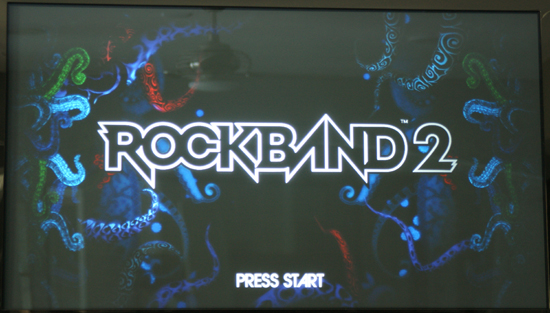
The tendrils in the background are really well animated. It's subtle but gives a great feeling of depth.
Unlike Guitar Hero, there is no real "quest" to complete. Rock Band 2 centers around playing music in different venues around the world to unlock more songs to play in additional venues. Aside from the ridiculous success and gigantic fan base that is easy to acquire in Rock Band 2. In real life you would not be able to do this if you were a lame cover band that didn't write their own stuff. But it's still pretty cool. Even with this ability to become an instant virtual Rock Star, Rock Band 2 really is, in essence, a band simulator.
For those who haven't had the opportunity to play either Guitar Hero or Rock Band, the concept can sound kind of lame. But the fun of these games really sneaks up on you. Whether you play an instrument or not, playing Rock Band with three friends to a sound track that it actually filled with a lot of good songs is really a satisfying experience. Even playing on your own is cool, but the multiplayer/party game experience is really where it's at.
Why is it fun? Well, it's a lot easier than playing a real instrument, but it still gives you that feeling that what you are doing is making music. At the same time, while there are different difficulty settings, the game can get really challenging. There are a lot of really complex songs to play (that even some decent musicians might not want to touch in real life) that are quite satisfying to master. For people who have never played a guitar or drums, it can give you a taste of what it's like. While the guitar is still really divergent from reality, the drums are quite close.
In fact, Rock Band 2 can essentially double as a real electronic drum kit. But we'll talk more about that later on. The game is very rhythm based (fitting as these are the types of games that the current music game genre emerged from) and the forms and patterns that gamers need to master range from straight forward and simple to very syncopated and fast. For gamers who like music, who like rhythm games, who like a challenge, or who want to feel like they are a rock star, this game is for you.
While Rock Band 2 is a clear upgrade from the first Rock Band, it feels more like an expanded and polished version of the original. This isn't necessarily a bad thing, as Rock Band was a fun game to begin with. Let's take a closer look at this latest installment in the Rock Band series from Harmonix.
The Instruments: The Guitar and Mic
While the original Rock Band hardware will work with Rock Band 2 (which is nice), Harmonix did see fit to release updated versions for Rock Band 2. We'll start with the new guitar. Here it is:
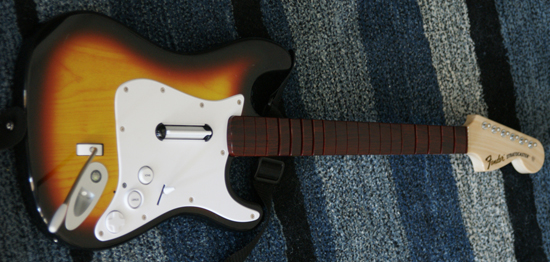
Hold your computer upside down to look at it if you're left handed.
The first thing people will likely notice is that it looks very similar to the first Rock Band guitar. The changes are mostly tweaks that improve the feel of the guitar when playing. The fret buttons feel a bit better to press down, and the strumbar feels more solid as well.
Not really sure what all that means? Let's take a look at the make up of a guitar controller.

These are the fret buttons. You hold them down when the game tells you too.
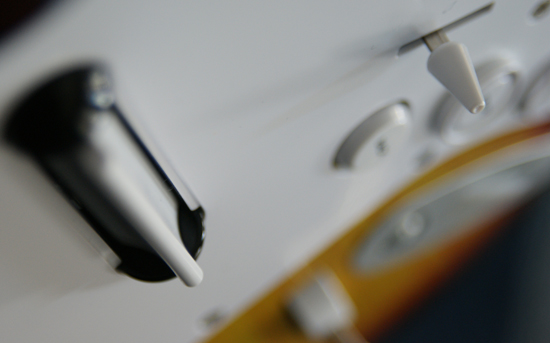
This is the strumbar. You "pluck" it ... like a string?
In order to play games with a guitar controller, a fret button (or two or three ...) is held down and then the strum bar is either pushed up or down to simulate "playing" the note. This can take some getting used to for people who haven't played guitar before. It imitates the way playing a guitar requires strings to be pressed down and then plucked to get different sounds. Guitar controllers are a little more forgiving with the timing of things, but the general idea is there.
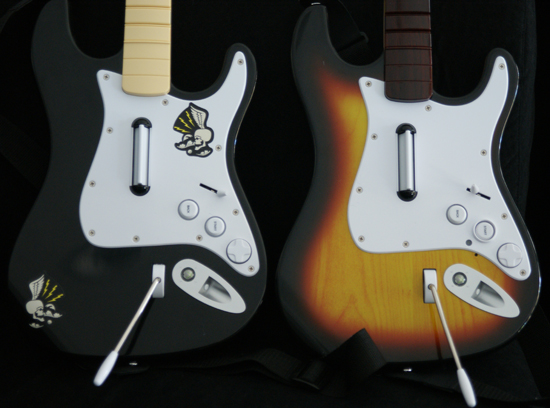
We haven't sticker'd up our new one yet.
Not all guitar controllers are created equal though. The Rock Band and Rock Band 2 guitars are only slightly different. But there is a much larger gap between the design of the Rock Band series of guitars and the Guitar Hero guitars. Some of the differences between the Rock Band and Guitar Hero guitars lead people to favor one style or another.
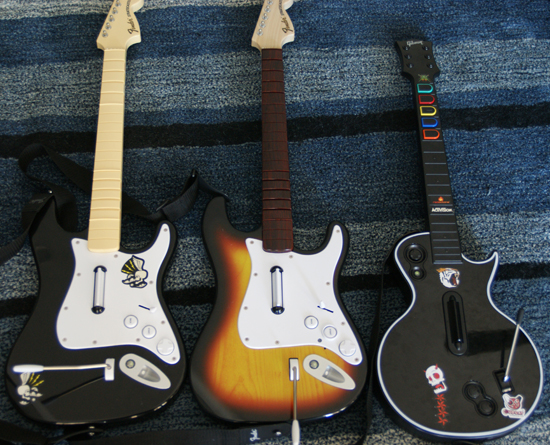
Pretty little maids all in a row.
In our opinion, the Guitar Hero strumbar is better as it has more tactile feedback. Many people prefer the way the buttons on the GH guitar are raised (making them a little easier to "find" if you get lost), but the RB and RB2 guitars are slightly more realistic in their design (with RB you feel ridges where frets with buttons slightly indented between as opposed to the raised and separated buttons on GH guitars). The kicker for us is that the Rock Band guitars feature buttons that are much easier to push down (the require less force to depress). This is a major plus, as playing fast or for long periods of time can be very difficult with the GH version (until you build up some major hand strength anyway).
The really new feature of the Rock Band 2 guitar is a built in camera and mic that can be used for automatic calibration. While automatic calibration is a great idea, there are some issues. But we'll cover that in the next section.
The guitar is wireless, and that's great, but it doesn't feature a rechargeable battery pack. It simply uses AA batteries. Wireless controllers just scream out for rechargeable batteries, especially when you've got the ability to charge over USB with the XBox 360. There is just no excuse for this.
Regardless of automatic calibration people are going to be polarized, and if you like one style of guitar controller you'll probably hate the other. For those who prefer the Rock Band guitar, the Rock Band 2 guitar is definitely improved, but not improved enough to warrant upgrading simply on the merits of the new version. At the same time, there's no reason to pick the older version if you need to buy a new controller.
The mic is still just a USB mic. It's not that great, and it isn't wireless. While everything else has the wireless option now, it's sad that we still have to be tethered to something with this one. But it does have a nice long cord and isn't going to really weigh you down that much. There isn't much interaction with the device really necessary, as it's just something you sing into.
It might be nicer not to require a controller to be used with it. Maybe Harmonix build a minimal range of buttons on there in the future to enable volume control and navigation around the screen a little easier. And then it'd be wireless and have more function. I wouldn't mind seeing a "premium" style mic with these sort of options. But for now, we're just stuck with a simple straight forward USB mic.
Automatic Calibration
One of the major things we were excited about with Rock Band 2 was the automatic calibration feature. For gamers who have trouble with calibration, there really hasn't been an easy way to get video and audio all matched up. This can cause all sorts of frustration. The Rock Band 2 guitar features a camera and a microphone that can be used to sense the actual delay down to the millisecond for both video and audio.
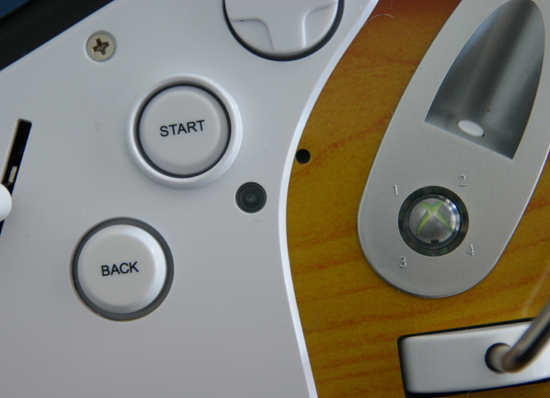
Those two circles in the center are the camera and mic. The camera is the bigger one.
The drawback is that automatic calibration isn't as consistent as we would have thought it would be. Depending on the distance from the screen or the speaker, we can see about a 5ms swing on video delay and a 10ms swing on audio delay. Calibration was more consistent when the controller was held right up to either the screen or the speaker, but generally people don't put their head right up next to a speaker when playing Rock Band.
The variability in the video wasn't something we could really notice and the automatic calibration worked very well. With the audio, the larger swing did have an impact we could feel. After calibrating it a few times and playing with it, we were able to decide what delay felt best and manually set it to that.
While we were less impressed with the automatic calibration than we thought we would be, it will absolutely do one thing to help out: it will make calibration consistent between different people's set ups. If I go to a friends house and play with their setup and they automatically calibrated it, I can expect the same degree of error I had when I set it up myself. It's not the be all end all of calibration, but it is certainly better than leaving it up to the eyes and ears of one person in a room who may or may not be able to match timing to sight and sound in tune with reality.
The Instruments: The Drums
The Rock Band 2 drum kit is definitely an improvement over the Rock Band 1 kit. Unfortunately, the area that needed the most TLC, the kick pedal, really isn't that much better. While disappointing, we definitely prefer the RB2 kit to the RB1 kit.
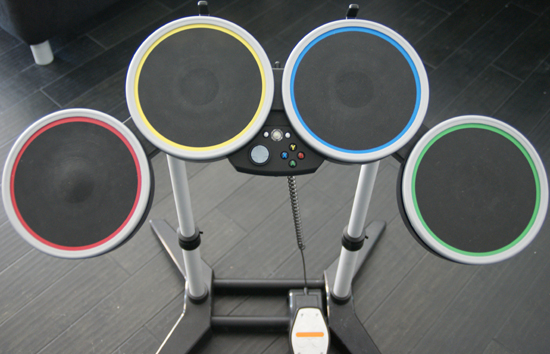
Looking down on the RB2 kit.
Both kits uses pads (called triggers) that the gamer hits with drum sticks in response to the game. The pads are statically mounted on a frame with an XBox 360 controller in the center. There is one kick pedal that sits below the pads and is use by lifting it up and pressing it down to simulate playing a kick drum on a real kit. While the RB1 pedal is flimsy plastic, the RB2 pedal is slightly reinforced.
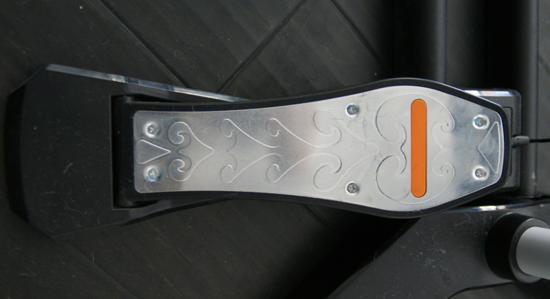
This is the new pedal. Much like the old one.
One of the weak spots, however, is the hinge that attaches the moveable part of the pedal to its base. This is where one of our RB1 pedals broke (The other pedal broke in half), so while the RB2 pedal will be less prone to a certain type of breakage, it is by no means much of an improvement in terms of absolute strength of the pedal. It does seem that they made the pedal a little "softer" (the spring doesn't seem to push as hard) so there may be less stress on the hinge, but this does sacrifice the feel of the pedal slightly.
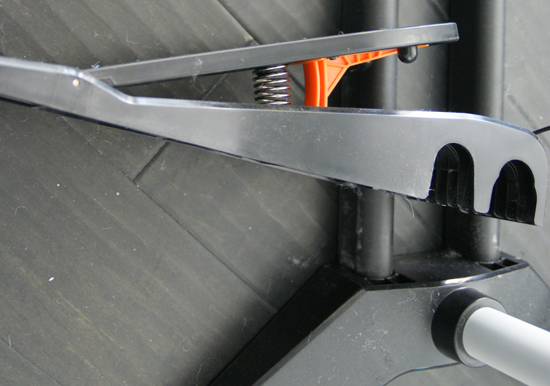
Squishy spring feels like slamming your foot into dry sand on the beach. Not satisfying.
But we still like the RB2 kit more, and here's why.
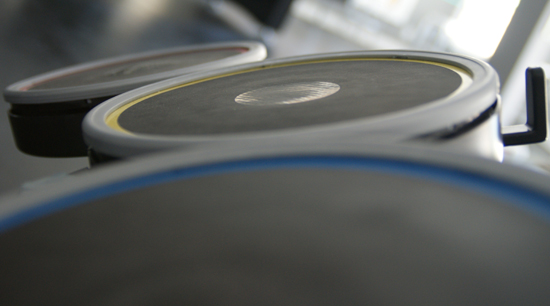
Mmmm ... Tasty bouncy rubber covered pads. Not perfect, but much better than the first attempt.
First, the pads feel much better. They are more responsive and at least a little quieter. The tone of a stroke (that's what it's called when you hit a drum with a stick) on the pads is much lower pitched and much easier on the ears as well. It's less distracting and allows the music to be less affected. The framing feels a little more sturdy than the RB1 kit as well, but we never really had any trouble with the the original kit in that regard so it may not be that much of an issue.
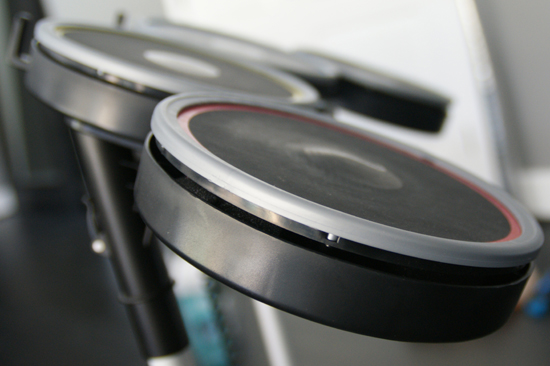
Can you see the bubble on the red pad? What's up with that?
And while there are some advantages with the new kit, there is a bit of an issue with the pads as well. Either the top layer of our pad shifted a bit and bunched in the middle or the softer rubber used stretched and dimpled in the middle. Which ever thing happened, we've got a slight bubble of rubber on our red pad. And this was only after a week or two of usage, as we switched to the ION kit as soon as we received it.
Other bonuses are the fact that the pads are somewhat pressure sensitive and the RB2 kit allows for the addition of cymbals for the yellow, blue and green triggers. Though these symbols count as the same color and you can hit either to play the game, when doing fills or playing in the drum trainer or freestyle modes, hitting the cymbal pads will produce cymbal sounds. The yellow blue and green pads act as toms and the yellow blue and green cymbals act as cymbals (hi-hat, ride and crash respectively). The ION kit comes with cymbal pads, but it stands to reason that because the RB2 kit has connectors for such devices that there will be an add on available at a later date.
The cymbal additions would be great for some things, as putting the yellow hi-hat cymbal to the left of the red snare (for right handed gamers) would put it in the position most drummers are used to. The advantage of this, however, is totally destroyed by the fact that the game sometimes changes the mapping of different cymbals and toms to different colors depending on the song and/or difficulty level. This means the hi-hat isn't always the hi-hat (sometimes the snare is the hi-hat) and sometimes the ride is actually an open hi-hat (which is even more frustrating).
The down side of pressure sensitivity is that it isn't all that sensitive. The range of volume is from sort of loud to loud and not much in between. While it does make for a little tiny bit of dynamic control, it simply does not add anything to the experience. It is a step in the right direction, but we need whole lot more flexibility to get excited about this feature.
The Instruments: The Premium Drum Kit
The bottom line is that the ION Drum Rocker (the premium Rock Band 2 kit) is better than the standard kit for gamers who are really into drumming with Rock Band. But it might not be the best solution for everyone, and drummers might just hate parts of it.
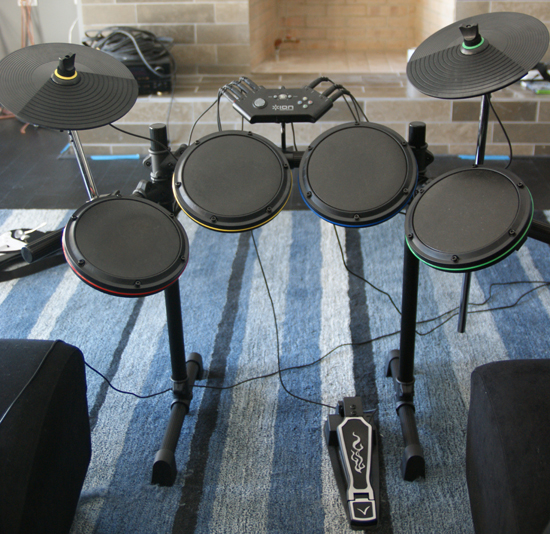
Wow, this actually looks like an electronic drum kit. Maybe that's because it is...
The kit comes with 6 triggers (4 pads and 2 cymbals), a foot switch, an adjustable rack, and a controller into which all the parts connect. A third cymbal can be ordered. The rack (and thus positions of all the triggers) is adjustable. In order to make small adjustments, pads can be moved up and down (or in and out) on their mount points; to make large adjustments, the positions of arms on the rack need to be changed.

So many bolts to adjust ... Lucky I always keep my drum key drill bit in my pocket.
But we lose something important with all the added flexibility and configurability of the premium kit: the ability to quickly adjust to multiple people. The standard kit includes very quick and easy height adjustment that can be used to adapt easily when more than one person wants to play the drums. In a party game environment, this is something that might end up being essential for people get the most out of their gaming experience.
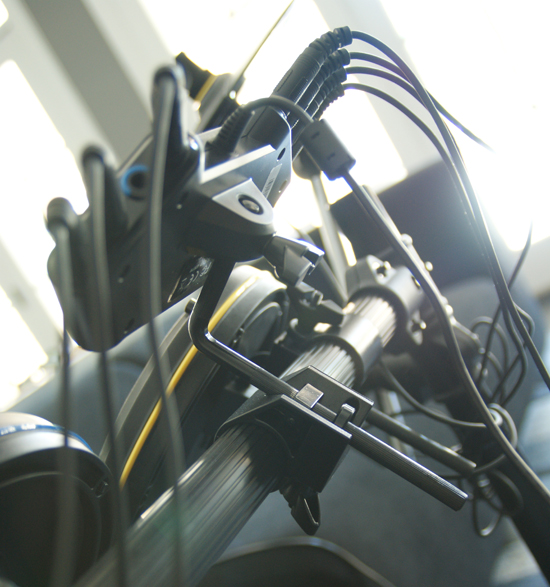
The back of the brain. Note the mount to the rack. All the pads have these and can move that much.
There is some flexibility in the mounding rods the drum pads are attached to that gives you some flexibility (depending on how you set it up). But if you need to drastically adjust the height of the premium kit (say if you have a small kid and a tall adult playing) you'll need to loosen multiple tension rods with a drum key, move multiple bars up or down, and then re tighten things. It's not quick or simple. Yes, if there is one drummer in the house, setting it up perfectly can be easier and more rewarding, but if you throw multiple cooks into the kitchen you're best option will be to get it somewhere between what everyone needs/wants. And in that case, you lose a lot of the advantage of the premium kit.
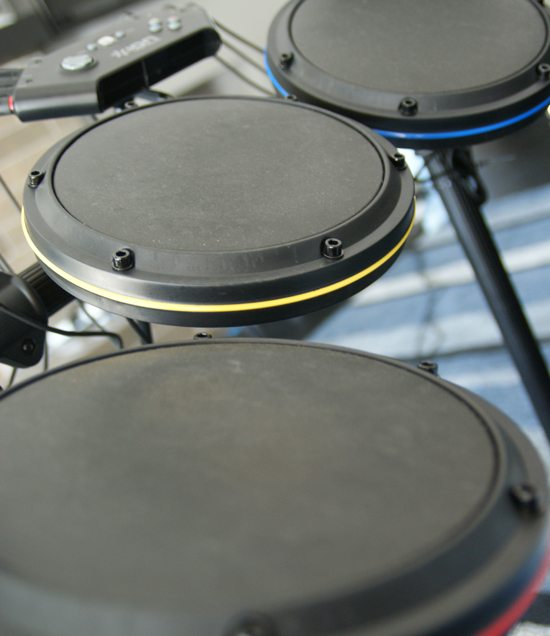
It ain't no V-Drums, but these pads are sweet compared to the standard kits.
There are plenty of other good things about the kit though. The pads are bouncier, which makes playing less of a chore, especially for those fast rolls. The cymbals feel a little flat (they absorb the impact and don't bounce back much) but if you aren't doing extended rolls on them there isn't really a problem here. But the real advantage (and downfall) of the premium kit is the kick pedal.
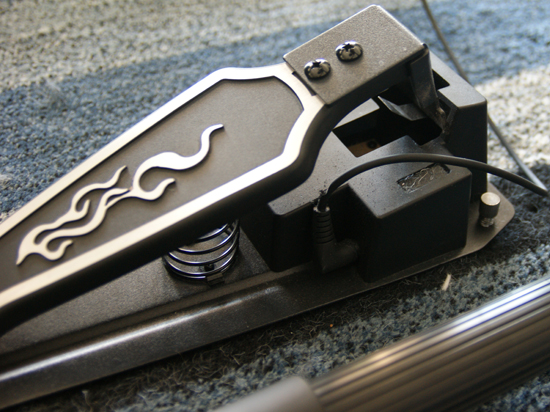
Rather than using a Roland TD-8 style pad attached to a real kick pedal, the premium kit makes use of a foot switch that, to go back to the Roland example, would normally be used as a hi-hat pedal. The pedal is very responsive but also really light. Meaning it doesn't take much effort to push it down, but it still pops back up pretty quickly. The problem drummers will have with it is that it doesn't bounce. I'll talk about that in a second though.
The kick pedal that comes with the premium kit is immensely better than the one that comes with the standard Rock Band or Rock Band 2 drums. It isn't perfect, but the advantage can't be overstated. Because of the reduced effort required to play with the foot-switch-turned-kick-pedal and the very small amount of movement required to open and close the switch, gamers will be able to play much faster and more easily for a longer period of time. For musicians, while the pedal is still a huge improvement over the standard offering, there is a lot to be desired.
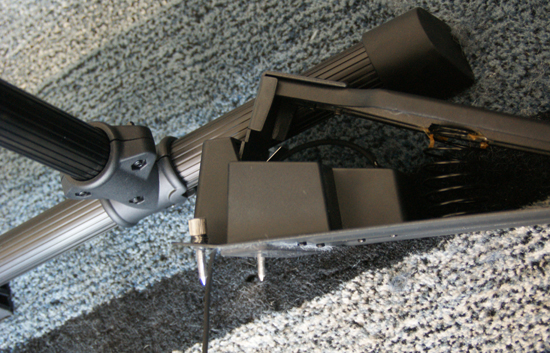
When playing with a real kick pedal and hitting an actual drum, there is a lot of reaction going on. With either Rock Band setup, you need to expend energy in both pushing the pedal down and lifting your foot up. With a real kick pedal, you can use the bounce to remove a lot of the effort required to to play fast bass drum beats. For simple beats, you will likely expend more energy when using a real kick, but quick double hits much harder than they need to be with Rock Band. And don't get me started on those thrash metal songs. My leg feels like it is going to fall off after some of that nonsense, and it gets really frustrating not having a better kick pedal option.
Some drummers may be able to get over the problems with using a hi-hat pedal as a kick drum, but I really just want to go with a Roland TD-8, a kickbox and my pearl pedal and be done with it. For me, the ION (premium kit) kick pedal, while better than the RB1/RB2 kick pedal, still isn't very good. Non-drummers will likely feel different and will more than likely love the upgraded kick option. But then almost anything is better than the stock piece of junk.
There are also some reliability issues. We've heard tales of some people having the kick pedal stick in the down position. And in a very disappointing turn of events, our pedal actually broke. There is a flimsy metal piece attached to the pedal that depresses an actuator located on the base to close the circuit. This metal piece snapped off while playing a rather simple and straight forward song. I play barefoot and while I'm sure I play a little harder than most non-drummers, I learned on an older Roland electronic kit back in the early-mid 90's so I've never been very heavy footed.
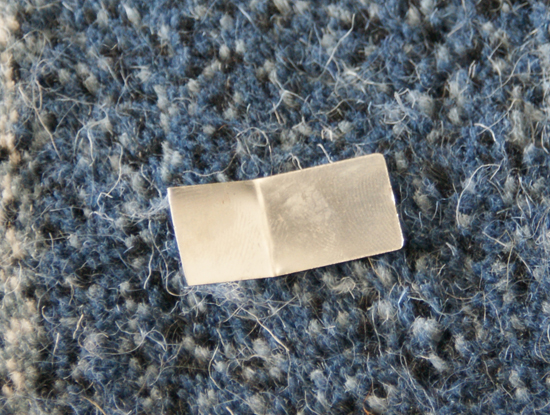
We thought about attaching something a little stronger to the pedal, but we rethought a repair attempt, as it is likely the flexible metal piece was used to absorb high impact and prevent damage to the switch itself. The fact that the actuator itself is mechanical leaves the ION kick pedal prone to breakage in a way that the RB1 and RB2 pedals just aren't. Sure, the horrible construction on both RB pedals can lead to breakage of the pedal itself (remember, the hinge of the RB2 pedal is still just plastic, and that is where one of our other pedals broke), but the mechanism that actually closes the circuit is actually much more likely to break on the ION pedal.

We were able to take the actuator and magnet out of one of our broken RB pedals and build it into a real kick pedal and practice pad set up with no problem. Others have taken their broken RB pedals and repaired them using wood or a metal plate or more plastic. Sometimes it's ugly, but it usually works. With the ION pedal, we were able to rig it up to keep functioning, but we're still waiting on a replacement.
A Quick Detour: Setting Up The Drums
Playing the drums, and by extension, playing with the drum controller on Rock Band 2, can be quite a work out. This gets even more amplified when people make it harder on themselves than it needs to be. There are ways that you can set up your drums, your throne (that's what drummers call the seat they sit on to play), and hold yourself in order to minimize the work you do while playing the game.
Some of the hardest stuff to do, because practice is required, are rolls and fast kick drum work. With both of these techniques, proper strength and endurance are required no matter how much natural timing a person has. And there are some songs that people can just brute force their way through, but you'll have an easier time both learning how to do these things and playing for an extended period of time if you follow these suggestions.
First, you need to determine how high you should sit. If you are sitting too high or too low, you'll be wasting a lot of energy every time you lift your leg to play the kick drum. When you are resting with your foot on the kick pedal, you want you knee to be slightly below your hip. Your leg should be nearly parallel to the ground, but you'll have a little bit more endurance if you are just a bit higher (if the angle your knee makes is a little greater than 90 degrees). This will be true whether you play with your heel up or down. An adjustable drum throne is the way to go, but you can also get by with adjustable chairs. Stools and fixed chairs are kind of hit or miss, and if more than one person is planning on playing drums a lot, you'll really want to go with something that can be raised and lowered easily.
After getting your seat height set, you'll want to look at where to position the drums. Sitting on your throne with your arms relaxed at your sides, lift you hands (bending at the elbows) until your forearms are parallel with the ground. You'll want the vertical center of the red and green drums to be at the height of your finger tips. When actually playing the drums, you'll want to hold your arms at about this angle (you'll need to shift slightly when moving between drums obviously), but in order to conserve energy, you will want to do most of your playing with your wrists.
We could get a lot more into technique, but there are plenty of resources around for those who really want to dig this deep. Whether or not you decide to play Rock Band 2 like a drummer would play the drums, playing the game will be easier on you if you set the drums up as I've outlined and remember to sit up straight. Good posture and the positioning of your seat and the drums will go a very long way to helping improve your experience with the game.
The Drum Trainer
Many, including ourselves, have talked about the potential for Rock Band not only to get people into drumming, but to help them learn as well. The drum controller is close enough to a real drum kit that people playing the game might accidentally learn a few things about playing drums. Unfortunately, teaching things like posture, fundamentals and technique isn't something Rock Band focused on.
With Rock Band 2, Harmonix made up for their lack a tiny bit by offering a Drum Trainer mode. The Drum Trainer consists of a few dozen different selectable beats that constantly loop until you hit stop. Tempo and the sound of the kit can be altered as well. This mode, as opposed to playing through a song, has the potential to teach people how beats feel to play rather than how to just play what they see. Playing the drums is more about timing and muscle memory than reflexes, and helping people move away from a play-what-you-see style will help people actually become drummers. If they want to.
In spite of the fact that you have the ability to move at your own pace and practice common beats, Rock Band 2 won't tell you if you are using a poor grip, moving your arms too much or if you are not using the bounce of the drum to your advantage. All of these things are important for people who are serious about playing, and learning poor technique can really get in the way down the road.
So the drum trainer is definitely a step in the right direction. It teaches you some rudiments without telling you what you are really learning, and it helps make the repetitive process of really learning how to play something a little more fun. But it still doesn't make Rock Band 2 the be all end all of learning tools for drums. In future versions, we would love to see some thing like some video tutorials of how to sit, hold your sticks, hit the drums, and all that good stuff. Just making the information available in the game would go a long way to helping save people from the need to un-learn things down the road.
Honestly, the best tool that Harmonix provided with Rock Band 2 isn't something that is geared specifically toward learning drums. Curious? Read on.
Rock Band 2: Cheap Electronic Drum Kit?
Aside from the great tutorials and the drum trainer, Rock Band 2 offers another mode that is pretty interesting. Freestyle mode allows the gamer to just play the drums. There are multiple options for different sounding kits, and what you end up with is essentially a cheap electronic drum kit. And when I say cheap I don't just mean inexpensive, I mean not all that great as well. But hey, this is a video game not a musical instrument... Right?
The intriguing bit is that we've seen much worse electronic drum pad setups than what you get with Rock Band 2. We are actually at a point where, if someone wanted to, they could learn to play drums for real with this setup and actually even jam with people. Sure, you don't have a hi-hat pedal, and unless you get the premium kit or add cymbals to the standard kit you are limited to only 5 different drum sounds (a snare, three toms, and a kick). But that's enough to get by with for someone starting out or just working on the fundamentals.
With the premium kit (or eventually with cymbals added on to the standard kit), even though cymbals and toms are the same color, hitting one or the other gives you a different sound. Thus, playing in Freestyle mode with an expanded kit gets you: a snare, three toms, three cymbals and a kick. Which is better. But there are still some serious limitations.
It's just not going to sound as good as when you play the game.
Here's the deal. When playing Rock Band and Rock Band 2, you aren't actually "playing" the sound that comes out. If you hit something with the right timing, the audio for that segment of the master track for that instrument is played. If you screw up, you are treated to a generic mistake sound rather than the sound that would actually have happened if you had hit the instrument you did when you did. It does actually make the songs sound more like the songs, but it is divergent from reality.
Even though Rock Band 2 incorporates some dynamics (if you hit the pad harder it the sound will be louder), the range of volume isn't very good at all. This gets in the way of really playing drums like they are meant to be played. With any electronic kit, you have to deal with reduced dynamic capability, but with the Rock Band setup this is especially lacking. It isn't as bad as either all or nothing, but it really isn't much better either.
Combining these last two points, the gamer, when playing the game, has no control over the way the song was recorded. The tracks have all been engineered with the right amount of compression, reverb, and whatever other effects were desired. On top of that, the subtle things that a drummer will do to get different sounds don't translate. For instance, the hi-hat roll on Everlong has some accents in it that can be created either by hitting the hi-hat slightly harder or quickly and slightly opening and closing the hats. You just can't get that sound from the kit unless it's playing back a recording.
The result is that in Freestyle mode (like when you have the opportunity to play a fill in the game), the kit will sound flat or mechanical or not organic or whatever hippy term you want to use that really means that it sounds bad. That isn't to say that you can't make the thing sound alright. You just have to know what it's good for and use it for that. Having higher expectations will almost certainly lead to disappointment.
The last point is that you can't really do anything with what you play in Freestyle mode in the game (sure, you can record it using an external device, but that's a little annoying). The upcoming Guitar Hero World Tour will allow people to record and even upload and share their tracks. This adds another dimension that, if done right, could really add value to a music game as a makeshift instrument. It remains to be seen whether or not Guitar Hero will deliver, but we are certainly hopeful. And even if it doesn't, we are glad that both Rock Band and Guitar Hero have gone in a direction that opens up the flexibility of their game for use as a real instrument. Even if it is a fairly bad real instrument.
But seriously, who learns to play guitar on a $5k drum kit or even a $500 guitar? Most people start out with crappy instruments anyway. And that's where the real value is in Freestyle mode. You (or your kid) use the drums to actually learn how to play drums. The old fashioned way. With time and effort and stuff. They might not sound great, but allowing people just to play opens up the opportunity for people to practice on their own. With all the tutorials on the internet, people can sit down and read (or even watch) a lesson and then take what they learned to Rock Band 2 and practice. Or you could actually take lessons from someone and get more hands on feedback. But either way, you do everything you need to in order to learn drums using Rock Band 2.
In the end, Rock Band 2 won't "make" someone a drummer. But, more so than its predecessor, this game provides tools that could definitely help people who want to become drummers. Hopefully people will take advantage of this. The world can always use more drummers.
The Songs
Obviously the game centers on the music. There are a few factors that go into a great sound track for a music game. First off, people need to be able to tolerate the songs they are hearing while they play the game. Aside from likability of the music, speed, complexity, and repetitiveness (or hopefully a lack there of), also play a large role in how fun the experience of playing the game ends up being.
There are actually quite a few songs that, while I had heard them before, I gained a real appreciation for them after playing them on Rock Band 2. If the beat or the melody or bass line or whatever is interesting and fun to play, the songs actually gain another attribute to the listener that can be positive or negative. It's sort of surreal and meta, but the special sauce on the music game genre is the fact that the music impacts the likability of the game while the game can also affect the perception of the music, creating a sort of echo chamber where appreciation for music is able to expand. Additionally, because of the way our brains access memories by association, hearing a song that was fun to play on Rock Band 2, whether you knew the song before you heard it in the game, can subconsciously enhance your enjoyment of the song.
But we're sort of getting away from our area of expertise here so let's bring it back home. As we mentioned, if you can't stand the songs, you probably won't want to put the time in to learn them and enjoy them in the first place. We feel the song list is very well rounded, has something for everyone, and features a couple songs that most people probably won't enjoy in order to add significant challenge to the game for those who've mastered it. Without further ado, here's the song list from Rock Band 2:
The Main Drag - A Jagged Gorgeous Winter
Motörhead - Ace of Spades '08
Grateful Dead - Alabama Getaway
The Replacements - Alex Chilton
Pearl Jam - Alive
Avenged Sevenfold - Almost Easy
The Guess Who - American Woman
Journey - Any Way You Want It
Jethro Tull - Aqualung
Joan Jett - Bad Reputation
Metallica - Battery
Steely Dan - Bodhisattva
Kansas - Carry On Wayward Son
System of a Down - Chop Suey!
Mastodon - Colony of Birchmen
The Offspring - Come Out and Play (Keep 'Em Separated)
Speck - Conventional Lover
Squeeze - Cool for Cats
Lush - De-Luxe
Disturbed - Down with the Sickness
Nirvana - Drain You
Beck - E-Pro
Foo Fighters - Everlong
Survivor - Eye of the Tiger
Dinosaur Jr. - Feel the Pain
Modest Mouse - Float On
Anarchy Club - Get Clean
AFI - Girl's Not Grey
Rise Against - Give It All
Red Hot Chili Peppers - Give It Away
Fleetwood Mac - Go Your Own Way
Cheap Trick - Hello There
Duran Duran - Hungry Like the Wolf
Social Distortion - I Was Wrong
The Muffs - Kids in America
Silversun Pickups - Lazy Eye
AC/DC - Let There Be Rock
Bon Jovi - Livin' on a Prayer
Presidents of the United States of America - Lump
Alice in Chains - Man in the Box
Tenacious D - Master Exploder
Jane's Addiction - Mountain Song
Lit - My Own Worst Enemy
The Donnas - New Kid in School
Bang Camaro - Night Lies
Panic at the Disco - Nine in the Afternoon
Linkin Park - One Step Closer
Blondie - One Way or Another
Lacuna Coil - Our Truth
Judas Priest - Painkiller
Dream Theater - Panic Attack
Interpol - PDA
Megadeth - Peace Sells
The Who - Pinball Wizard
L7 - Pretend We're Dead
Talking Heads - Psycho Killer
Elvis Costello - Pump It Up
The Allman Brothers Band - Ramblin' Man
Bikini Kill - Rebel Girl
That Handsome Devil - Rob the Prez-O-Dent
Steve Miller Band - Rock'n Me
Ratt - Round and Round
Guns N' Roses - Shackler's Revenge
Bad Company - Shooting Star
Breaking Wheel - Shoulder to the Plow
Beastie Boys - So What'cha Want
Testament - Souls of Black
Norman Greenbaum - Spirit in the Sky
Soundgarden - Spoonman
The Sterns - Supreme Girl
Bob Dylan - Tangled Up in Blue
Sonic Youth - Teen Age Riot
Rage Against the Machine - Testify
Paramore - That's What You Get
Jimmy Eat World - The Middle
Rush - The Trees (Vault Edition)
Smashing Pumpkins - Today
Devo - Uncontrollable Urge
Abnormality - Visions
The Go-Go's - We Got the Beat
Libyans - Welcome to the Neighborhood
The Mighty Mighty Bosstones - Where'd You Go
Billy Idol - White Wedding (Part 1)
Alanis Morissette - You Oughta Know
But that's not where it ends. For owners of Rock Band (or those who can get their hands on a Rock Band disc), all but three of the original songs are able to be imported into Rock Band 2. This really just copies the songs to the hard drive of the console and allows Rock Band 2 to treat these tracks in the same manner it would downloadable content. Of course, this costs $5. This is basically a re-licensing fee that authorizes the copy of the tracks to the hard drive. This is likely there to get around the potential for people to "pirate" songs by sharing Rock Band discs without paying for the song contained therein at all. This way, even though people have to buy their music twice, there is no way record companies will miss out on at least a portion of their royalties.
To extend this a bit further, as an added bonus, any Rock Band downloadable content can also be accessed via Rock Band 2. So for gamers who have been into Rock Band and purchased songs, Rock Band 2 will allow you to continue to enjoy these all under one upgraded roof. Thankfully, it is free to use your Rock Band DLC with Rock Band 2.
Anyway, here is the list of Rock Band songs that can be imported into Rock Band 2. The three that are not allowed to be used with the new game are: Enter Sandman, Paranoid, and Run to the Hills.
Jet - Are You Gonna Be My Girl
Sweet - Ballroom Blitz
Soundgarden - Black Hole Sun
Ramones - Blitzkrieg Bop
Hole - Celebrity Skin
Smashing Pumpkins - Cherub Rock
Radiohead - Creep
Red Hot Chili Peppers - Dani California
Fall Out Boy - Dead on Arrival
Kiss - Detroit Rock City
Blue Öyster Cult - (Don't Fear) The Reaper
The New Pornographers - Electric Version
Faith No More - Epic
Molly Hatchet - Flirtin' with Disaster
Boston - Foreplay/Long Time
The Rolling Stones - Gimme Shelter
Queens of the Stone Age - Go with the Flow
The Outlaws - Green Grass and High Tides
OK Go - Here It Goes Again
Deep Purple - Highway Star
Garbage - I Think I'm Paranoid
Nirvana - In Bloom
Foo Fighters - Learn to Fly
The Hives - Main Offender
Yeah Yeah Yeahs - Maps
Mountain - Mississippi Queen
The Police - Next to You
R.E.M. - Orange Crush
The Strokes - Reptilia
Beastie Boys - Sabotage
Weezer - Say It Ain't So
The Clash - Should I Stay or Should I Go
David Bowie - Suffragette City
Nine Inch Nails - The Hand That Feeds
Rush - Tom Sawyer
Aerosmith - Train Kept A-Rollin'
Stone Temple Pilots - Vasoline
Bon Jovi - Wanted Dead or Alive
Pixies - Wave of Mutilation
Coheed and Cambria - Welcome Home
The Killers - When You Were Young
The Who - Won't Get Fooled Again
If all that weren't enough, at some point Harmonix will be releasing 20 free songs via its online music store. No word on what or exactly when yet though.
The music store has been revamped and integrated into Rock Band 2 a little better by the way. It's an improvement over the original Rock Band method of dealing with DLC (exclusively through Microsoft's interface). Now we can preview songs and look at their difficulty rating before we buy them. It is still unfortunately not obvious which songs that were part of packs are already owned, so you still have to be careful not to buy the same thing twice. The only other real down side is that you can't do anything else until a song is finished downloading. There's no way to cue up multiple downloads and let it go: they all need to be done individually and sequentially. Which is a pain in the butt if you want to buy a lot of songs at once.
Anyway, we are happy with the improvements made to the online store, but there is still room to make it better next time around. In addition to tweaking the issues we've already pointed out, we would also like to see longer previews or previews of multiple sections of songs that highlight interesting bits of the song for different instruments. Oh, and better or more accurate difficulty ratings.
Song Difficulty Ratings
With the original, the difficulty category of the song didn't always do a good job of conveying how hard the song would be for any given instrument. Some songs are just difficult on one instrument while others might be hard across the board. It is just a fact of music that writers don't normally consider the difficulty of the music they create (except in as much as it needs to possible for some musician to play it).
Rating the difficulty of each instrument in each song on a scale of zero to six and putting the song in an overall difficulty class seemed like a really good idea. Except Harmonix did a horrible job of rating difficulty per instrument. Because of this the difficulty ratings mean absolutely nothing.
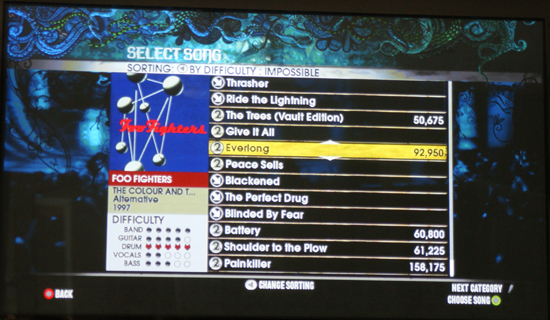
Everlong. Great song. A beast on expert drums.
It is true that different people are good at different things, and thus sometimes it will be easier for one person to play something than it is for another. But even so, it escapes us just how the ratings could be this useless.
Well, there are a couple cases where you know what you are getting. With a rating of zero, the song isn't going to be that hard to play. If you are looking at five devils, it is incredibly likely you'll need to practice quite a bit as it is going to be hard. But everything else is a crap shoot.
Honestly, people tend to like playing songs they like, so difficulty rating isn't a make or break feature. But if we are going to get it, there is no reason not to do it right. As it is, its just a disappointment.
As it isn't really clear how these songs are rated, we can't really comment on how things went wrong. But we do have at least one suggestion for how things could be done that might help.
It might be helpful to have different difficulty ratings for each difficulty level per song. The difficulty doesn't always translate when you move to a different level. Everlong is a perfect example of a song that is almost simplistic on hard but really deserves its five devil rating on expert. Actually getting this information to the gamer might be difficult, but unless the information is useful, it doesn't matter how accessible the data is.
New Interfaces and Game Modes
There are some slight tweaks to the interface with Rock Band 2 over the original. There isn't any different in the actual game play portion but when moving around the menus and selecting options there are differences. When selecting a song, different category arrangements can be selected (by difficulty, alphabetically, by genre, etc.), and you can easily jump between categories. What ever song is currently selected has it's info displayed to the left (artist and album as well as the difficulty rating information). This is an improvement over Rock Band, but it still feels a little clunky and it's not as easy to use as it should be.
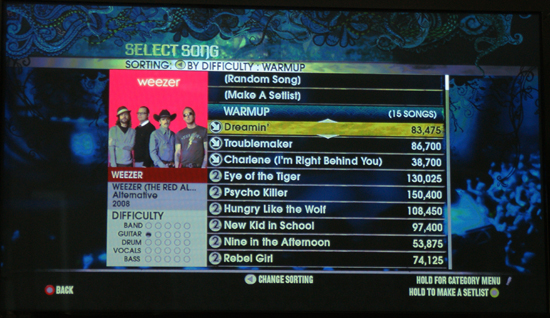
Can't go wrong with Weezer. This one is much easier than Everlong.
Yeah, we're going to take the easy way out here and not suggest a way to improve it. Honestly, organizing 84 songs in a way that its easy to find what you want is hard. It gets even more difficult after 55 more songs from the Rock Band disk are added and at least a good 3 or 4 dozen downloaded songs are thrown in for good measure. Again, this is definitely an improvement over their first attempt, but we hope Harmonix continues to make improvements in this area.
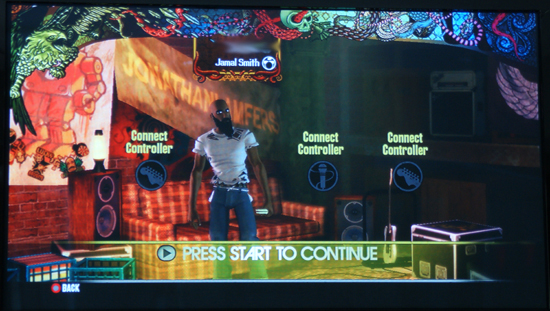
My band is setup, but I have to hit start to move on. Cool.
One subtle interface tweak that we do appreciate is the fact that when you are setting up your band to play, you can connect all your instruments but not everyone has to join in to play. those who are going to play press the button to join and select their character. Once all that is done, you need to press start to continue. This saves us from accidentally doing something like hitting the green button to fast and moving on when we shouldn't be and it keeps us from having to back out one screen further and disconnecting an instrument to play with a different group of people. This is useful in party settings or when playing with varying numbers of people or maybe two people who want to cycle between all 4 instruments.
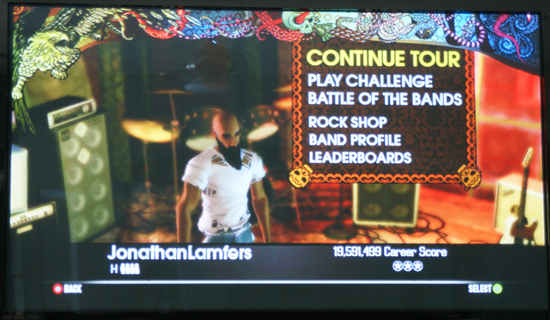
And now what to do ... We spend most of our time on tour.
The tour mode in Rock Band 2 is very similar to the tour mode in the first one. Gamers select different cities and different venues within those cities to unlock more songs and access more venues and more cities. The number of fans you can win (and the speed with which you win them) is much higher in Rock Band 2, and the addition of managers that alter the rewards or random set modifiers that can pop up is an interesting distraction, but nothing really fundamentally changed with this game play mode.
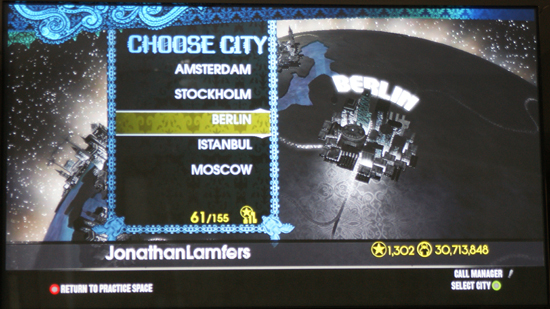
Getting around on Tour.
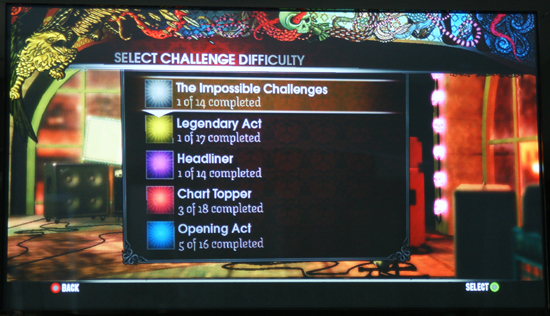
And now looking at challenges.
Challenge mode, while still essentially offering sets to play, organizes songs in groups that target specific instruments or themes. Some challenges require single or multiple players and completing challenges can unlock things other than songs like clothing sets for your characters. This is fun for a change from just playing random songs or making your own sets, but some of the ideas that Harmonix had about the difficulty of their challenges is way off. There's no way that the apprentice drum marathon should include Tangled up in Blue. That song is tricky and evil for "apprentice" drummers.
Battle of the Bands mode isn't really as cool as it sounds. You basically play against the score of another band online. While the battles can be cool sometimes (getting the most stars in a no fail set or the longest streak of notes in an impossible song or something), it's still not two bands going head to head on the same stage. With Rock Band 2, you can play online with friends (or strangers) as part of your band, so it doesn't seem like it should be a problem to have more interaction between two distinct bands. In any case, Harmonix updates the battles quite frequently and it has been fun to try and push up through the ranks on some of the challenges. Fun and humbling anyway.
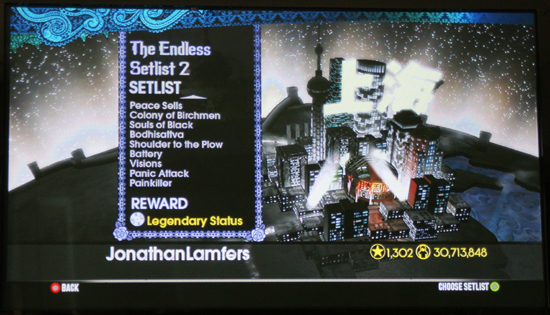
Endless 2.
Completing a new song in any game play mode will unlock that song for quick play or for custom sets in the tour mode, but for gamers who want to get right to the party all the songs can be accessed via a code that enables a game modifier that can be toggled. This means that you can grind through on your own and enjoy unlocking things, but when friends come over to party you can offer them all the variety the game has to give. No fail mode can be enabled as well, but that seems to kind of take some of the fun out of it.
Really, the interface could be better, but they did make it prettier. The backgrounds are subtle but immersive and what goes on on stage while the game is being played is better looking as well. It's impressive how well Harmonix sync'd lips, strumming, fingering, and drum work with the music. All the venues in the tour mode have their own unique atmosphere and feel as well. It's not easy to watch what's going on while playing, but it is a nice bit of polish.
Multiplayer Support and Online Matching
While it was possible to play online in Rock Band, there are new multiplay possibilities at our finger tips with the second installation. It is now possible to join a band (or have someone else join your band) to play songs on the normal tour. There are pluses and minuses to this new setup, but it is a step in the right direction for online play.
One of the major pluses is that you can play online and still continue to unlock stuff. This is only a factor until everything is actually unlocked, but many other games where things are unlockable don't fit online play into this model very well. Rock Band 2 does a good job here. This, and the simple fact that you can play with your friends, is about where the goodness ends though.
Part of the fun of playing with your friends is laughing at (or yelling at) them when the fail out or save someone. Sitting alone and playing the game, while still very fun, is still sitting alone and playing the game even if other people are playing along elsewhere. It's not a bad thing, it's just not as great as having everyone in the same place. Playing online with your friends is definitely a good option to have. But what if you don't have any friends (or maybe they just aren't online ... yeah that's it)?
The interface that allows you to get started filling in slots for your band online isn't really intuitive. When you are joining your band, you press the yellow button and wait. And wait. And wait a lot. But that's how matchmaking can be at times. Once you finally have another member or two for your band, you can continue on and do whatever you want on your tour.
But you don't know who you're playing with. They could be awesome or terrible. They could like fast stuff or slow. They might not have the 6 or 7 hours free it would take to run down the entire endless set list right now. This little frequently encountered issue results in people frequently quitting in the middle of a set. And this can be really frustrating. You lose fans, you lose time, you have to drop back out and start over if you want to play with someone else online. Yes, talking about what you want to do with the people you've joined does help, but not everyone uses their headset while playing. And it seems like no one ever wants to sing online. If you sit around waiting for a vocalist (at least until more people get the game and want to sing) the delay in getting going is vastly increased.
If you are the one joining someone else's band rather than inviting people to help you with your tour or challenges or whatever, you do still lose fans if you fail and gain fans if you win. But if you decide to quit in the middle, you lose much less than if you stuck it out to the end, thus encouraging you and your band mates to screw each other. A larger penalty for dropping out might help keep people going even when they are down, but it would also unfairly piss off people who have legitimate connectivity issues (or a pet that trips over the power cord -- yes it happens).
And then there's the major complaint. The game makes you fail out no matter what after someone disconnects, this can be incredibly frustrating if someone pulls out at the last song in a set. It seems like it makes you keep failing every time you start the song over after someone has quit as well, though we can't tell if it's just that everyone else follows suit and quits preemptively.
We hope that as more people pick up the game online play and matchmaking will go more smoothly and quickly, but it is a little difficult to predict. If you have friends you can play with online, great. If you want matchmaking and don't mind a little bit of a wait, then that's fine too. But the major drawback to playing online is having people drop out in the middle of sets and thus making everyone else fail out. We wish that Harmonix had gone a different route and allowed a band where someone dropped out to keep playing as if it had started with fewer players.
Leeway, Forgiveness, and Accuracy
One change that we have mixed feelings on is the fact that Rock Band 2 is quite a bit more forgiving than the original. If you get a little sloppy on your timing, the game will still give you credit for playing correctly. You still can't totally miss something or add in an extra hit anywhere, but if you are a little late or a little early with something, RB2 is more likely to give you the benefit of the doubt.
This is good in that it can make the game less frustrating, but we were a bit worried it might take away from the experience if there weren't a real strict requirement to be on beat. Thankfully the change is subtle enough to be helpful while not just handing over victory. You still have to be fairly close on timing, but the extra wiggle room can come in handy.
There are some limitations to this added flexibility though. In songs with 16th notes or triplets, there still isn't much that gets by without being fairly accurate. Additionally (on the drums anyway), if two things need to be hit at the same time, then they really need to be hit at the same time. In other words, while timing for the hits might have some leeway, the game expects you to do things simultaneously more ... simultaneously ... where appropriate. This keeps the difficulty for songs with rolls nice and high.
Overall, we are happier with the leniency of Rock Band 2, but we still have some complaints when it comes to adding things in that aren't there. Some songs still leave out notes, and it can get frustrating for people who actually know how to play the songs. We still really want to see a music game where people can add things in on beat that fit the song without being penalized.
We aren't asking for the allowance of random hits anywhere, but things that actually fit. In our vision, if we were to set the difficulty to hard but play all the notes in the expert track, we would expect not to be penalized. Like wise if the game is set to expert but we decide to play reality, we'd like not to lose points. If the developers aren't going to map all the notes to something in the game, musicians shouldn't lose out for it.
Sure there are some tracks where doing everything would be fairly near god-like, and most likely very frustrating for mere mortals. But if every other note of a 32nd note roll is left out for the sake of playability, the game should really know what is acceptable in terms of going beyond the required notes.
The worst offender is the kick pedal really. There are a good number of songs in Rock Band 2 that are actually played with 2 kick drums (or a double kick pedal). Translating this down to a single pedal is really annoying. One hit on the kick translating to two just throws me off, even if it is the only way to actually get the song to sound right without requiring people to do impossible things with one leg.
It's possible to add a double kick to the game though. For those who really don't mind spending money to do this, you can get a Roland TD-8 and a kickbox with a double kick pedal. It doesn't add any functionality to the game, but being able to use both feet to do some of the things the game expects of one might be a nice option.
We would love to see some sort of double kick option that would throw all the notes at you if you plugged in a second pedal. Of course, this is some crazy hard stuff to do when playing real drums, but isn't that part of the fun? Maybe with the next version.
Final Words
So. What's the verdict?
The kick pedal still sucks for the standard drum kit, the difficulty ratings are nearly useless, online play leaves a little to be desired in that the system doesn't penalize people who drop out enough, there are still parts of songs that don't get translated into doing something (with double kick pedal songs going way over the top), and automatic calibration isn't as consistent as we would like. It's almost like a glorified expansion pack that offers some refined bells and whistles and doesn't require the purchase of the original game.
But it really is a great game in spite of all that. One we wouldn't want to do without, especially when playing with 1 or 3 friends who also like music games.
If you own Rock Band with all the instruments, you can spend $60 for 84 songs plus expanded online play, a better (but still lacking) interface, and a few neat extras. At worst, it's just shy of 72 cents per song, which isn't a bad deal even if you aren't crazy about all of them, and at best you'll have a lot of fun with all the additional features and options.
For gamers who haven't purchased the first game and really want to play immediately, skip the first and go straight to Rock Band 2. And then "find" a Rock Band disk somewhere and import the original songs. They charge you five bucks to do so, so we've got no qualms recommending it.
For everyone else who might happen to be sitting on the fence when it comes to music games, there is a an unknown looming out there in the distance. With the monetary investment it takes to get one of these games that comes with some sort of makeshift drum kit, no one is really going to want to pick up both Rock Band or Rock Band 2 and Guitar Hero World Tour kits. Yes, the Rock Band and Rock Band 2 drum kits can be used with Guitar Hero World Tour, but you lose the use of one pad, so it will change the experience a bit. There are certainly some unique things that Neversoft is trying out that could add a lot of value to the game, but we've had our hands on Rock Band 2 and know it's fun.
Our recommendation for the most part is for people who don't already have a Rock Band drum kit sitting around somewhere to wait and see what Guitar Hero World Tour ends up being like. These games are definitely investments, and the release is right around the corner. Certainly you won't go wrong with Rock Band 2, but it isn't the be all end all game that it could have been. There were improvements made, but it is fundamentally the same game it was before. Guitar Hero has a chance to capitalize on this, and we're not going to jump the gun on recommending one over the other until we've got both in our hands.
If you don't look at it like a one over the other situation, then, by all means, pick up Rock Band 2. You won't be disappointed. Yes it could have been better, but that doesn't mean it's still not awesome.







